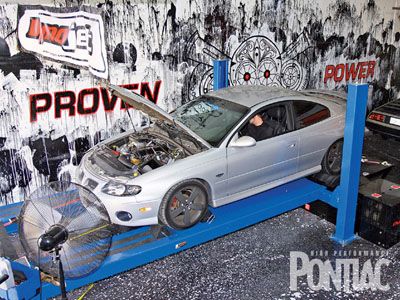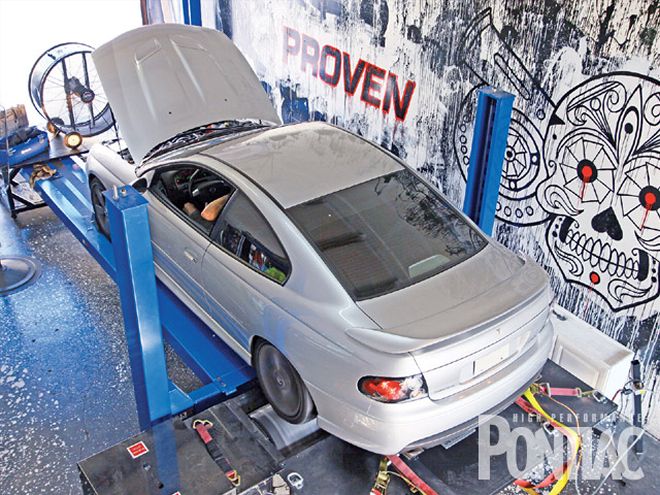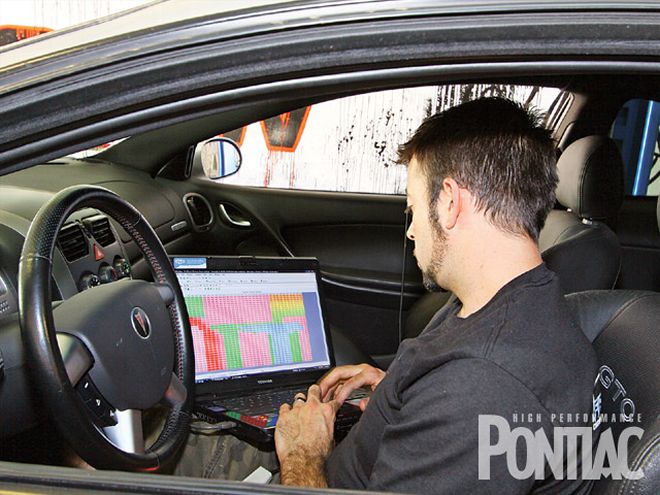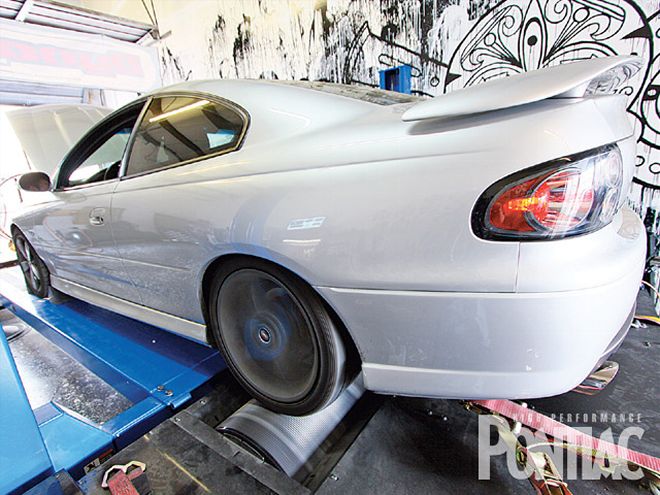
 Proven Power of Tampa uses a 224xLC Dynojet, which features a load-control attachment to simulate road load. This allows the tuning to be more effective and precise for real-world driving conditions. All pulls are made in the 1:1 gear of the car. In this case, being an M6, Fourth gear is 1:1. If it was an A4, it would be Third gear. This is essentially the gear the car will be in when going through the traps in the quarter-mile.
Proven Power of Tampa uses a 224xLC Dynojet, which features a load-control attachment to simulate road load. This allows the tuning to be more effective and precise for real-world driving conditions. All pulls are made in the 1:1 gear of the car. In this case, being an M6, Fourth gear is 1:1. If it was an A4, it would be Third gear. This is essentially the gear the car will be in when going through the traps in the quarter-mile.
When HPP was approached by Jeremy Formato at Fasterproms about increasing the power in our '05 6.0L LS2 GTO without breaking the bank, we were all ears. He suggested a simple swap to a cost-effective, hand-ported intake manifold and throttle body, accompanied by a custom tune.
The ported intake and throttle body package cost $400 when providing cores for each. There is no charge for installation and the tuning costs $400, for a total of $800. These budget mods are great for anyone looking to unleash the power potential in their LS2-equipped Pontiac, and Jeremy and his staff have become quite adept at it.
In spite of having a large 90mm throttle body out of the box, the LS2 intake manifold doesn't flow as well as the smaller 76mm LS6 manifold. Jeremy says this is due to the design of the plenum and disruption of airflow, but he still believes that the LS2 intake manifold has a lot of potential. He can tap into it by increasing plenum volume, smoothing out rough edges caused by the friction-welding molding process, and enlarging the intake runner ports and throttle body. "There is a lot of material inside that doesn't need to be there and has absolutely no structural importance," he says. "By smoothing these areas out or eliminating them completely, I'm able to increase plenum volume and also flow." Knowing how much to take out and where is the real trick, and the numbers we saw from our experience tell us he has it figured out.
 Jeremy makes adjustments to the stock computer through HP Tuners software. Establishing a base tune is always a good idea because it can show you exactly where changes need to be made.
Jeremy makes adjustments to the stock computer through HP Tuners software. Establishing a base tune is always a good idea because it can show you exactly where changes need to be made.
It's best to leave porting like this to professionals because you're dealing with thin plastic. The worst-case scenario could leave you with a hole in your runner and vacuum leaks. Fasterproms has ported manifolds and throttle bodies in stock to exchange for your unported cores. This makes the entire swap quick and easy. Jeremy jokes that he has done so many, he could probably swap an intake and throttle body in a very short time. Since we had to take photos and ask questions throughout the task, it took a bit longer.
Jeremy explains the technique he will use to tune our GTO. "There are a few things that can be done to optimize the combination, such as tuning the spark and fuel curves. Most any modification that alters the way air and fuel enter and exit the motor should be tuned for. Our objective here is to look at the whole picture; how and why spark and fuel mixtures are altered to complement modifications, and how to optimize them."
"Take for example this GTO," he adds. "It already has a good Volant cold-air system and a Corsa Sport aftercat exhaust system, and we're going to upgrade to a ported intake manifold and throttle body. The intake manifold will now provide an increase in volumetric efficiency at wider throttle opening from 2,000 rpm on up, so the spark and fuel curve should be revised for optimal performance. The engine requires less spark advance due to the higher fill rate of the cylinder from the intake manifold mods.
 The result of mild tuning was an additional 8 rwhp and 8 lb-ft of torque. Jeremy says there is more to be found if he focuses on a full tune before the manifold swap. He reviewed the entire tune and made very mild fuel and timing changes, deleted torque management, adjusted the electric fans, and deleted the annoying skip-shift feature. When it was all said and done, we were in a pretty good ballpark.
The result of mild tuning was an additional 8 rwhp and 8 lb-ft of torque. Jeremy says there is more to be found if he focuses on a full tune before the manifold swap. He reviewed the entire tune and made very mild fuel and timing changes, deleted torque management, adjusted the electric fans, and deleted the annoying skip-shift feature. When it was all said and done, we were in a pretty good ballpark.
"Every car and combination is unique. If we were to leave the spark alone with a greatly improved induction system, we could encounter preignition or spark knock. With less spark lead on this particular combo, we are igniting the mixture at the proper time in order to get the most efficient burn and push the piston back down.
"Typically, the wide-open-throttle spark curve will be the reciprocal of the torque curve. If you've ever looked at a dyno sheet and seen that the torque curve looks like a hill, the optimal spark curve, if plotted out, many times will look like a valley. Where an engine produces best torque is where it has the highest VE (builds the most cylinder pressure) and generally needs the least amount of spark advance. When the cylinder fill is less, more spark advance is required."
Jeremy also stresses that more ignition timing does not always translate into more power. Spark advance is merely a medium of achieving maximum cylinder pressure for combustion.
Jeremy discusses fuel curves: "Typically, stock heads-and-cam LS motors make the best power at a 13:1 air-to-fuel ratio. I tuned both the base VE table and the MAF tables for optimal response, performance, and economy--no, they are not mutually exclusive. With certain highly modified naturally aspirated combinations, the air/fuel ratio at which the motor makes best power can be between 12:1 to 13.5:1, but there are many variables. On this car, we found that 12.7-13:1 was what it wanted to make the best power and stay away from knock. Different air/fuel ratios change the combustion temperature. Leaner can make more power, but if it's too lean, power will fall off and/or cause spark knock."
Since we were at a new dyno facility, we couldn't just rely on our previous numbers. We we needed to establish a new baseline. The staff at Proven Power of Tampa tightened the straps to secure the GTO and we made our first pull, which resulted in 346 hp and 342 lb-ft of torque. These figures were a bit down from our old runs, but they will give us an accurate measurement for our gains.
Jeremy put in a mild tune so we could see just how much was left in our combination before any changes. With a few tweaks, the power was increased to 354 hp and 350 lb-ft of torque. That's an increase of 8 hp and 8 lb-ft to the wheels, respectively. That's not too shabby for about five minutes of educated tuning alterations.
With our baselines completed, we focused on the new parts and began hunting for big power. Check out the photos and captions to see how much we got.